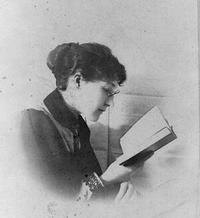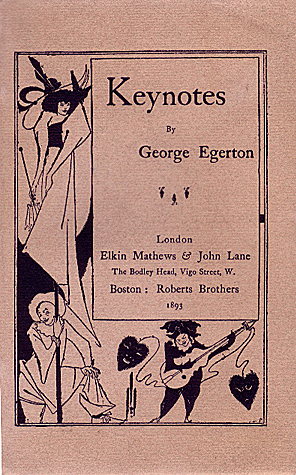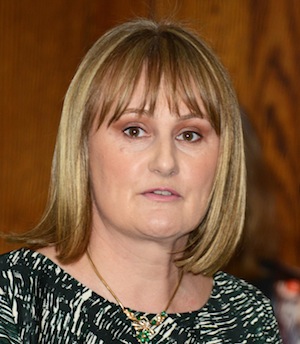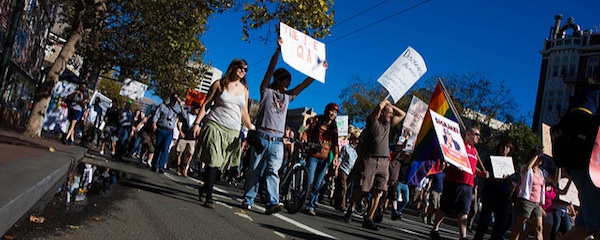
photo crop © Victor Zminkowski, 2010
*
In this longlisted essay from the 2016 THRESHOLDS Feature Writing Competition, Eleanor Fitzsimons profiles the life and writing of ‘New Woman’ George Egerton.
~
George Egerton: Writing a ‘Topsy-Turvey’ World
by Eleanor Fitzsimons
Surely, a proto-modernist writer whose experimental approach and provocative themes were echoed, decades later, in classic works by James Joyce and D.H. Lawrence should enjoy an enduring reputation. No one would countenance the neglect of an author whose challenging first collection of short stories, Keynotes, sold more than six thousand copies in its first year, was translated into seven languages, and influenced Hardy’s Jude the Obscure. Yet the name George Egerton is rarely mentioned outside academic circles.
Perhaps Egerton, a woman, ensured her own neglect by engaging in unflinching criticism of the patriarchy. In ‘Now Spring Has Come’, the second story in Keynotes, she insisted that woman should embrace her true and turbulent nature, when she wrote: ‘the untrue feminine is of man’s making.’ Egerton’s sensual exploration of such dangerous themes provoked a backlash so intense that Punch magazine reflected the unease she incited among its Victorian readers by parodying her viciously in ‘She-Notes’ by ‘Borgia Smudgiton’.
Best remembered – if remembered at all – for Keynotes, Egerton was born Mary Chavelita Dunne in Melbourne, Australia, in 1859, to Isabel George, a Welsh Protestant, and Captain John J. Dunne, an Irish Catholic. A militiaman’s daughter, Egerton’s unsettled childhood unfolded between Australia, Chile and New Zealand, where her father participated in the brutal suppression of that country’s indigenous Maori people. She was also educated for a time in a German Catholic boarding school. The early death of her mother, when Egerton was just fourteen, obliged her to abandon aspirations of becoming an artist in order to spend her formative years in and around Dublin, helping her widowed father to raise her younger siblings. As a result, she considered herself ‘intensely Irish’. Several of her stories tackle Irish themes: ‘The Marriage of Mary Ascension’ explores clerical and parental oppression in middle-class Ireland, while ‘Mammy’ includes an account of prostitution in Dublin.
Once her father could spare her, Egerton trained as a nurse and lived in New York for a time, before returning to Ireland as travelling companion to the Hon. Charlotte Whyte-Melville. When Captain Dunne discovered that Whyte-Melville’s husband, Henry Higginson, an Episcopalian priest, was having an affair with his daughter, he threatened Higginson at gunpoint, prompting Egerton to flee to Norway with her lover. Their marriage, contracted in June 1888, endured for less than a year and, shortly afterwards, Higginson, a volatile alcoholic, died of complications related to his illness. Although Egerton lived in Norway only briefly (she soon moved on to London), her time there honed her literary abilities. A talented linguist, she had learned Norwegian and immersed herself in the works of Henrik Ibsen, August Strindberg and Nobel Prize-winner Knut Hamsun, with whom she enjoyed a brief romance and whose work she translated into English. She used her relationship with Hamsun as the inspiration for ‘Now Spring Has Come’. Egerton also studied the writings of Friedrich Nietzsche a decade before they were translated into English; she references him in several of her stories.
 In November 1891, Egerton married Egerton Tertius Clairmonte, a Canadian citizen and struggling novelist whose lack of success obliged her to take up her own pen in order to supplement the family income. It helped that the couple had moved to rural Ireland where Egerton encountered few distractions. Her pseudonym paid tribute to her late mother, whose maiden name she took, and also to her husband. Remarking that this was ‘the only provision that he ever made for her’, Egerton’s biographer, Terence de Vere White, noted: ‘Her elopement with Higginson gave her the material for a book; her second husband, by his dependence on her, gave her the motive to employ it.’ George, the couple’s only child, was born in 1895, the same year his parents divorced. By then, John Lane and Elkin Mathews of the Bodley Head had published Keynotes (1893), which Egerton dedicated to Knut Hamsun, her former lover.
In November 1891, Egerton married Egerton Tertius Clairmonte, a Canadian citizen and struggling novelist whose lack of success obliged her to take up her own pen in order to supplement the family income. It helped that the couple had moved to rural Ireland where Egerton encountered few distractions. Her pseudonym paid tribute to her late mother, whose maiden name she took, and also to her husband. Remarking that this was ‘the only provision that he ever made for her’, Egerton’s biographer, Terence de Vere White, noted: ‘Her elopement with Higginson gave her the material for a book; her second husband, by his dependence on her, gave her the motive to employ it.’ George, the couple’s only child, was born in 1895, the same year his parents divorced. By then, John Lane and Elkin Mathews of the Bodley Head had published Keynotes (1893), which Egerton dedicated to Knut Hamsun, her former lover.
In a series of interlinked stories, Egerton’s first collection explores the gradual acceptance by her female protagonists that the purity required of them was a patriarchal construct imposed in order to deny them sexual freedom and fulfilment. In ‘Now Spring Has Come’, she was scathing in her criticism, writing:
Men manufactured an artificial morality; made sins of things that were as clean in themselves as the pairing of birds on the wing; crushed nature, robbed it of its beauty and meaning, and established a system that means war, and always war, because it is a struggle between instinctive truths and cultivated lies.
Egerton’s women reject their proscribed roles as guardians of morality, and refuse to engage in the heteronormative courtship plots familiar to readers of the time. Instead, they cooperate with other women, often overcoming constructed ethnic and social divisions in pursuit of agency and self-determination. ‘Woman, where her own feelings are not concerned, will always make common cause with women against men’, she wrote in ‘The Spell of the White Elf’, the third story in Keynotes.
While most of Egerton’s heroines are white middle- and upper-class women, in ‘Under Northern Sky’, Marie Larsen, a maidservant, entertains her drunken master with compelling tales in a bid to ensure that her mistress enjoys an uninterrupted night. In doing so, she ‘[takes] the enemy by stratagem’. The emancipated women that populate these dangerous and destabilising stories prompted comparison to Ibsen and sparked intense speculation as to the true identity of their author. Reviewing Egerton’s collection for The Academy in 1894, literary critic William Sharp described her fictional world, where women explore their desires and pursue supportive relationships with other women, as ‘topsy-turvey’.
Although closely associated with the fin-de-siècle New Woman movement, Egerton was uncomfortable with her inclusion: ‘I am embarrassed at the outset by the term ‘New Woman’’, she admitted. In an interview with American periodical Book Buyer, she confessed to having no views on ‘emancipation’ or the ‘woman question’. Unlike true New Woman writers, Egerton adopted an essentialist approach to gender, encouraging women to abandon all ambitions of emulating men in order to focus on the realisation of their own potential. In her epistolary and largely autobiographical novel Rosa Amorosa, she wrote:
Broadly speaking, woman has given most of her energy to a development of masculine qualities, instead of a cultivation to the utmost of the best in herself – as woman – with the object of producing the finest type of womanhood.
Although her exploration of sexual emancipation and self-actualisation resonated with New Woman preoccupations, Egerton shunned notions of equality. Yet, while she envisaged an alternative calling for woman, her forthright language reflected the fury of the burgeoning women’s rights movement. In ‘Now Spring Has Come’, she wrote:
What half creatures we are, we women! – hermaphrodite by force of circumstances, deformed results of a fight of centuries between physical suppression and natural impulses to fulfil our destiny.
Egerton loathed the duplicity of Victorian society, which she summed up in a sardonic letter to her father, writing: ‘sin as you please but don’t be found out it’s all right so long as you don’t shock us by letting us know.’ Little wonder her protagonist in ‘A Cross Line’, the first story in Keynotes, dreams of escape:
A great longing fills her soul to sail off somewhere too – away from the daily need of dinner-getting and the recurring Monday with its washing, life with its tame duties and virtuous monotony.
Although Egerton intended ‘A Cross Line’ to be the last story in her collection, the Bodley Head insisted it go first since, as Professor Margaret Stetz argued:
With its plot based on casual adultery, its references to unwed mothers, and its flattering portrayal of a woman who drinks whiskey, goes fishing alone, and smokes cigarettes, ‘A Cross Line’ […] guaranteed attention for the whole book.
Fearless in her choice of theme, Egerton also subverted conventional genre boundaries that set long-form and short-form fiction apart. Norwegian academic Gerd Bjørhovde insists that readers were ‘as shocked by the way she wrote as by what she wrote’. Her stories spill into each other, chasing themes from first page to last, as she explores the innate wildness of a  woman’s nature and allows her female protagonists to seize opportunities for self-knowledge and control of their destiny. In Discords, her darker and far less successful second collection of stories, Egerton documents the barriers women collide against when attempting to break free from rigid Victorian norms. Here, she explores alcoholism, marital abuse, prostitution and suicide. In ‘Virgin Soil’, the fifth story in the collection, a newly married woman is destroyed by her ignorance of the sex act.
woman’s nature and allows her female protagonists to seize opportunities for self-knowledge and control of their destiny. In Discords, her darker and far less successful second collection of stories, Egerton documents the barriers women collide against when attempting to break free from rigid Victorian norms. Here, she explores alcoholism, marital abuse, prostitution and suicide. In ‘Virgin Soil’, the fifth story in the collection, a newly married woman is destroyed by her ignorance of the sex act.
Only in ‘The Regeneration of Two’, the last story in Discords, does Egerton sound a hopeful note, allowing her protagonist to enjoy a fulfilling, non-marital romance and a gratifying career helping other women. As American scholar Martha Vicinus suggests, this decision to lighten the tone may reflect Egerton’s ‘need to imagine a better world where women work together and men understand and keep their freedom too’. It is telling that she set this story in her beloved Norway rather than Victorian England, where she had made her home by then. While Egerton had plenty of detractors, she had supporters too. In 1895, publisher John Lane, with whom she had a romantic liaison, wrote to her from America, assuring her that her stories were ‘very much in the air’ there. Adopting the title ‘Keynotes’, he published a series of New Woman fiction under the Bodley Head imprint.
Egerton also wrote for quarterly literary periodical The Yellow Book: her story ‘The Lost Masterpiece’ was included in the very first issue in April 1894, and her connection with this publication created an association with the Decadent movement. By echoing Oscar Wilde’s style in several of her stories, and quoting him in an epigram to ‘A Little Gray Glove’, the fourth story in Keynotes, she reinforced Wilde’s association with New Women’s writing. Several passages in ‘A Cross Line’, which imagine a dance in a ‘dream of motion’, take much from Wilde’s Salome, although Egerton’s woman dances for her own pleasure and not in an attempt to satisfy the male gaze:
She can see herself with parted lips and panting, rounded breasts, and a dancing devil in each glowing eye, sway voluptuously to the wild music that rises, now slow, now fast, now deliriously wild, seductive, intoxicating, with a human note of passion in its strain.
This dancing woman is acutely aware of the undermining decorative role she is expected to fill, a common theme in New Woman writing. In a show of solidarity, she wonders if other women feel the same.
Egerton’s association with Wilde, and the consequent discontinuation of The Yellow Book, damaged her reputation. Although she wrote five short story collections, an epistolary collection, one novel, and several plays, she never replicated the success of Keynotes. Her decline coincided with her marriage in 1901 to drama critic and literary agent Reginald Golding-Bright, who was fifteen years her junior. Following his example, she became drama agent to George Bernard Shaw, who produced her first play, and also to Somerset Maugham. Egerton, known by then as Mary Chavelita Bright, passed the final four decades of her long life in relative solitude and died in 1945. As one obituary writer put it:
George Egerton’s death brings back to mind the so-called ‘new woman’ school of fiction of the nineties in which the ‘problems’ of the relations of the sexes for the first time in English literature were put before a somewhat bewildered Victorian public.
Interest in Egerton has grown in recent years but she remains neglected in comparison to contemporaries such as Olive Schreiner, Sarah Grand, and Mona Caird. Yet, her unique brand of feminist writing is worthy of our interest and her revolutionary ideas had a significant influence on several groundbreaking writers, both male and female.
~
 Eleanor Fitzsimons is a researcher, writer and journalist who specialises in historical and current feminist issues. She has an MA in Women, Gender and Society from University College Dublin. In 2013 she was awarded the Keats-Shelley Essay Prize and was runner-up for the Biographers’ Club Tony Lothian Prize. Her work has been published in a range of newspapers and journals including The Sunday Times, the Guardian, History Today and The Irish Times. She is a regular contributor to radio and television, and and she blogs for The Romanticism Blog and the BARS Blog. Her book Wilde’s Women: How Oscar Wilde Was Shaped by the Women he Knew was published by Duckworth Overlook on 16 October 2015 and will be available in paperback from 8 September 2016.
Eleanor Fitzsimons is a researcher, writer and journalist who specialises in historical and current feminist issues. She has an MA in Women, Gender and Society from University College Dublin. In 2013 she was awarded the Keats-Shelley Essay Prize and was runner-up for the Biographers’ Club Tony Lothian Prize. Her work has been published in a range of newspapers and journals including The Sunday Times, the Guardian, History Today and The Irish Times. She is a regular contributor to radio and television, and and she blogs for The Romanticism Blog and the BARS Blog. Her book Wilde’s Women: How Oscar Wilde Was Shaped by the Women he Knew was published by Duckworth Overlook on 16 October 2015 and will be available in paperback from 8 September 2016.

